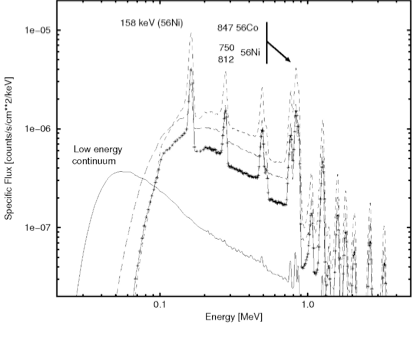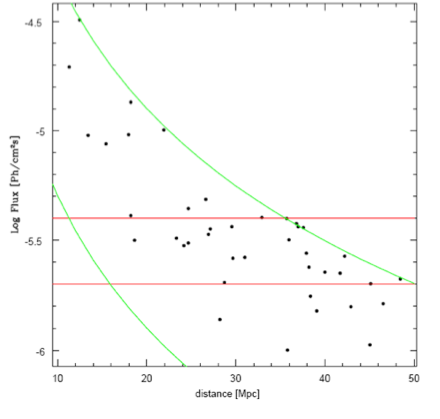Understanding the physics of supernova explosions
Thermonuclear supernovae yield profound results for modern precision cosmology – the accelerating Universe, yet we do not understand their progenitor systems, the initiation or propagation of nuclear burning, the origin of the observed variation in peak luminosities, or its metallicity dependence. Measurements of 56Ni masses and distributions in a sample of nearby events will help clarify the physics of SN Ia.
-
• What are SN Ia progenitor systems ?
-
• What produces the variation in 56Ni mass and peak brightness ?
-
• How does the nuclear flame proceed through the white dwarf ?
A direct view of 56Ni-56Co in Type Ia supernova explosions is required to answer these questions, understand their explosion mechanism and solidify their use as standard candles for Cosmology.
SN Ia are the outcome of a thermonuclear burning front that sweeps a carbon/oxygen white dwarf in a close binary system and synthesizes iron-peak elements in the inner regions, intermediate mass elements (Si, S, Ca) where burning is incomplete and unburned material (C, O) in the outer layers. The evidence for this scenario is based on supernova spectra and on the statistical properties of galaxies that host such events. Nevertheless, questions as basic as which systems explode, how the white dwarf approaches the instability and ignites, and how the flame propagates through the star still demand an answer. This is troublesome for cosmology since the use of SN Ia as standard candles depends on an empirical relationship between the shape and the maximum of the light curve (Phillips 1993). This relationship has been proven to be extremely useful up to now, but the requirements of precision cosmology demand better understanding as well as the certitude that the accuracy is not eroded by evolutionary effects for supernovae at large distances.
Although this relation is closely related to MNi, it cannot be explained by this parameter alone and other factors like the total mass burned, the amount and distribution of stable iron, radioactive nickel and intermediate mass elements must combine in quite a tight way to reproduce observations (Woosley et al. 2007). Some of these factors depend on the evolution of the white dwarf prior to the explosion and cast some doubt on the use of SN Ia as high precision distance indicators. It is of critical importance to disentangle the role of these factors to understand the limits of this relation. This is more urgent since the discoveries of the super-Chandrasekhar SN Ia, which are very bright, and apparently, do not follow the empirical relation.
Most diagnostic are the amount of nickel synthesized and its distribution within the explosion debris. A first estimation can be obtained from the Arnett's law or modeling the emission at the nebular phase. But it can be better obtained from the γ-ray emission from the decay chains 56Ni -> 56Co -> 56Fe and 57Ni -> 57Co -> 57Fe. Differences in the amount of radioactive material, in the distribution within the ejecta as well as in the density, velocity and chemical composition profiles translate into the intensity and temporal evolution of the radioactive lines as well the Compton continuum spectrum (Burrows 1990; Kumagai & Nomoto 1997; Gómez-Gomar et al. 1998; Milne et al. 2004; Isern et al. 2008). Detailed measurements of these can clarify how the burning proceeds, and how uniform this is. Interpretations are relatively straightforward, as non-LTE effects are unimportant, and opacities are better known than in other energy ranges of the spectrum.
The 158, 812 keV 56Ni lines peak very early, near maximum light and, because of absorption, they are weaker than those of 56Co. An early detection of these lines could provide information about the location of 56Ni in the outer layers. The prominent 847 keV 56Co line reaches its maximum intensity roughly two months after the explosion. By then, the debris has expanded so much that the intensity of the line is essentially determined by the total mass of the radioactive isotopes. Though there are many lines emitted, just two in a narrow band, at 812 keV and 847 keV, provide essentially all the available information on Ni in the outer layers, and in bulk, respectively. These studies are not realized yet because the lack of sensitivity of current detectors in the region of 1 MeV, which allow the measurement of Ni/Co lines up to a distance of only 8 Mpc, reducing the possibility of observing SN Ia to at best a few fortuitous cases. The content of MNi depends on the supernova subtype. Roughly speaking it goes from more than 1 Mo in the overluminous cases to a mere 0.08 M in the most underluminous cases. Therefore, this measurement must be obtained for a statistically relevant sample.
A simple examination of the supernova catalogues indicates that not all the supernovae are detected before maximum light and in many cases the precise distance to the host galaxy or the necessary data to obtain the distance from the supernova itself is lacking. A conservative estimation from the Sternberg catalogue indicates that with a sensitivity of 2×10−6 ph/cm2/s (broad line), the Laue lens of DUAL could determine from the 56Co 847 keV line the amount of 56Ni synthesized during the explosion, for a sample of at least 30 supernovae of all subtypes during a period of 4 years. Also the ASCI can measure the complete evolution of the spectrum of any SN Ia that fortuitously occurs at distances smaller than 6 Mpc.

Gamma-ray spectrum for a Type Ia supernova at a distance of 5 Mpc 20 days after the explosion, for different models (Gómez-Gomar et al., 1998).

A conservative estimate of the number of SN Ia that can be observed for a given sensitivity, based on the Sternberg Astronomical Institute Supernova Catalogue that provides the apparent magnitude at the moment of discovery or at maximum and the galaxy redshift (Ho=72 km/s/Mpc). The sample quoted here corresponds to the supernovae that were detected from January 2002 to December 2006. This procedure automatically takes into account all the selection effects. The flux has been obtained for the 56Co 847 keV line, assuming a 3% broadening and a 56Ni mass assigned to each event according to a Monte Carlo distribution of subtypes.
